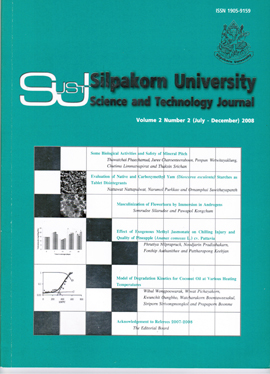Evaluation of Native and Carboxymethyl Yam (Dioscorea esculenta) Starches as Tablet Disintegrants
Main Article Content
Abstract
Native yam starch and carboxymethyl yam starch (CMS) were evaluated as tablet disintegrants incomparison with various starches i.e., corn starch, tapioca starch and rice starch. Direct compressioncomposition comprised dibasic calcium phosphate as a filler, each starch at various concentrations between3-15% w/w as a disintegrant and magnesium stearate as a lubricant. Hydrochlorothiazide (HCTZ) was used asa model drug for drug dissolution testing. Tablet properties including hardness, friability, disintegration anddissolution were evaluated. The results showed that tablet hardness increased with the amount of starch in thetablets. Tablets containing yam starch and rice starch showed higher tablet hardness than other native starches,while the tablets containing CMS showed obvious superior hardness to that of the other starches. Thedisintegration of tablets containing native yam starch was faster than that of tablets with corn, rice, and tapiocastarches. With increasing native starch concentrations, the disintegration of the tablets was found to be faster.Tablets with CMS disintegrated in a similar manner to those with native yam starch when the concentrationswere up to 9% by weight. The disintegration was delayed with higher concentrations. The HCTZ tablet withyam starch as a disintegrant gave faster initial dissolution than the others. It can be concluded that native yamstarch and its carboxymethyl derivative can be used as superior disintegrants in tablet formulation.
Downloads
Article Details
References
Alves, R. M., Grossmann V. M., Ferrero, C., Zaritzky, N. E., Martino, M. N., and Sierakoski, M. R. (2002). Chemical and functional characterization of products obtained from yam tubers. Starch, 54: 476-481.
Arthur, H. and Kibbe. (2000). Handbook of Pharmaceutical Excipients, 4thed. American Pharmaceutical Association, Washington D.C.
Bandelin, F. J. (1989). Compressed tablets. In Pharmaceutical Dosage Forms: Tablets (Liberman, H. A., Lachman, L., Schwartz, J.B., eds.), vol.1, pp.173-177. Marcel Dekker, New York.
Brunnschweiler, J., Luethi, D., Handschin, S., Farah,Z., Escher, F., and Conde-Petit, B. (2005). Isolation, physicochemical characterization and application of yam (Dioscorea spp.) starch as thickening and gelling agent. Starch, 57: 107-117.
Freitas, R. A., Paula, R. C., Feitosa, J. P. A., Rocha, S., and Sierakowski, M. R. (2004). Amylose contents, rheological properties and gelatinization kinetics of yam (Dioscorea alata) and cassava (Manihot utilissima) starches. Carbohydrate Polymers, 55: 3-8.
Fuhrer, C. (1996). Interparticulate bonding characteristics of pharmaceutical compacts. In Pharmaceutical Powder Compaction Technology (Alderborn, G., and Nystrom, C., eds.) pp.1-15. Marcel Dekker, Inc., New York.
Hill, P. M. (2006). Effect of compression force and corn starch on tablet disintegration time. Journal of Pharmaceutical Sciences, 65(11): 1694-1697.
Ingram, J. T. and Lowenthal, W. (1966). Mechanism of action of starches as a tablet disintegrant I: factor affect the swelling of starch grains at 37 °C. Journal of Pharmaceutical Sciences, 55: 614-617.
Kawrueng, P. (2005). Physico-chemical properties of yam (Dioscorea esculenta) starch. Chemistry Senior Project Report. Faculty of Sciences, Silpakorn University.
Kerf, M. D., Mondelaers, W., Lahorte, P., Vervaet, C., and Remon, J. P. (2001). Characterization and disintegration properties of irradiated starch. International Journal of Pharmaceutics, 22: 69-76.
Marshall, K., and Rudnic, E.M. (1990). Tablet dosage forms. In Modern Pharmaceutics (Banker, G.S., and Rhodes, C.T., eds.) pp.355-471. Marcel Dekker, Inc., New York.
Orelli, J. V. and Leuenberger, H. (2004). Search for technological reasons to develop a capsule or tablet formulation with respect to wettability and dissolution. International Journal of Pharmaceutics, 287: 135-145.
Riley, C. K., Wheatley, A. O., Hassanc, I., Ahmad M. H., Morrisona, E. Y. A., and Asemota, H. N.(2004). In vitro digestibility of raw starches extracted from five yam (Dioscorea spp.) species growth in Jamaica. Starch, 56: 69-73.
Shujun, W., Hongyan, L., Wenyuan, G., Haixia, C., Jiugao, Y., and Peigen, X. (2006). Characterization of new starched separated from different chinese yam (Dioscorea opposite Thumb.) cultivars. Food Chemistry, 99(1): 30-37.
Stojanovic, Z, Jeremic, K., Javanovic, S., and Lechner, M. D. (2005). A comparison of some methods for the determination of the degree of substitution of carboxymethyl starch. Starch, 57: 79-83.
Tester, R. F., Karkalas, J., and Qi, X. (2004). Starch-composition, fine structure and architecture(Review). Journal of Cereal Science, 39: 151-165.
Thiengthirathum, S. (1995). Tablet disintegration properties of modified tapioca starch. M.S. Thesis in Pharmacy. Faculty of Graduate Studies, Mahidol University.
USP 27/ NF 22 (2004). The United States Pharmacopoeia 27/ The National Formulary 22, The United States Pharmacopoeial Convention Inc., Asian edition, Port City Press, Baltimore.
Vorasuntharosoj, P. (2001). Plant Resources of South East Asia: PROSEA, Sahamit Printing, Bangkok.
Wurzburg, O. B. (1986). Modified Starches: Properties and Uses. CRC Press, Inc., Florida.
Yu, B., Fujii, S., and Kishihara, S. (1999). Physicochemical property of huaishan (Rhizama Dioscorea) and matai (Eleocharis dulcis) starches. Starch, 51: 5-10.


